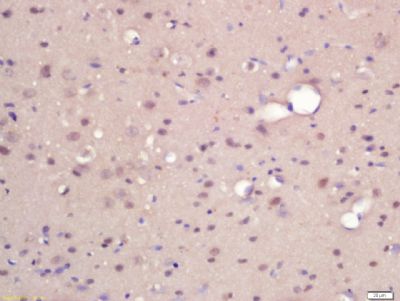产品货号 : mlR11973
英文名称 : ZNF423
中文名称 : 锌指蛋白423抗体
别 名 : Early B cell factor associated zinc finger protein; Ebfaz; hOAZ; Nur12; OAZ; OLF 1/EBF associated zinc finger; OLF1/EBF associated zinc finger protein; Olf1/EBF-associated zinc finger protein; Roaz; Smad and Olf interacting zinc finger protein; Smad- and Olf-interacting zinc finger protein; Zfp104; ZFP423; zinc finger protein 423, mouse, homolog of; Zinc finger protein 423; ZN423_HUMAN; ZNF423; ZNF423 zinc finger protein 423.
研究领域 : 细胞生物 神经生物学 信号转导 生长因子和激素 转录调节因子 细胞分化 锌指蛋白 表观遗传学
抗体来源 : Rabbit
克隆类型 : Polyclonal
交叉反应 : Human, Mouse, Rat, Dog, Pig, Cow, Zebrafish, Sheep,
产品应用 : ELISA=1:500-1000 IHC-P=1:400-800 IHC-F=1:400-800 ICC=1:100-500 IF=1:100-500 (石蜡切片需做抗原修复)
not yet tested in other applications.
optimal dilutions/concentrations should be determined by the end user.
分 子 量 : 145kDa
细胞定位 : 细胞核
性 状 : Lyophilized or Liquid
浓 度 : 1mg/ml
免 疫 原 : KLH conjugated synthetic peptide derived from human ZNF423/OAZ:901-945/1284
亚 型 : IgG
纯化方法 : affinity purified by Protein A
储 存 液 : 0.01M TBS(pH7.4) with 1% BSA, 0.03% Proclin300 and 50% Glycerol.
保存条件 : Store at -20 °C for one year. Avoid repeated freeze/thaw cycles. The lyophilized antibody is stable at room temperature for at least one month and for greater than a year when kept at -20°C. When reconstituted in sterile pH 7.4 0.01M PBS or diluent of antibody the antibody is stable for at least two weeks at 2-4 °C.
PubMed : PubMed
产品介绍 : OAZ is a 30-zinc finger, DNA-binding factor that associates with members of the Smad family of transcription factors in response to BMP2 activation. Bone morphogenic proteins (BMPs), are the largest group within the TGF∫ growth factors superfamily and are involved in embryonic development, specifically the formation of left-right asymmetry, neurogenesis, organogenesis and skeletal development. BMPs bind to surface receptors, which then phosphorylate serine residues of specific Smad proteins to induce Smad translocation to the nucleus and transcriptional activation of BMP targeted genes. OAZ specifically cooperates with the BMP-activated Smads, namely Smad1, 5 and 8, in binding to the CAGAC and TGGAGC boxes within the BRE, or BMP response element, and activating transcription. OAZ contains a BMP signaling module formed by two clusters of fingers that individually associate with either the Smads or the BMP response element. Distinct regions of OAZ, separate from the modules involved in BMP regulation, also enable OAZ to function as a transcriptional partner of Olf-1/EBF in olfactory epithelium and lymphocyte development, indicating that, as a multi–zinc finger protein, OAZ may have dual roles in signal transduction during development.
Function:
Transcription factor that can both act as an activator or a repressor depending on the context. Plays a central role in BMP signaling and olfactory neurogenesis. Associates with SMADs in response to BMP2 leading to activate transcription of BMP target genes. Acts as a transcriptional repressor via its interaction with EBF1, a transcription factor involved in terminal olfactory receptor neurons differentiation; this interaction preventing EBF1 to bind DNA and activate olfactory-specific genes. Involved in olfactory neurogenesis by participating in a developmental switch that regulates the transition from differentiation to maturation in olfactory receptor neurons. Controls proliferation and differentiation of neural precursors in cerebellar vermis formation.
Subunit:
Homodimer (By similarity). Interacts with EBF1 (By similarity). Interacts with SMAD1 and SMAD4. Interacts with PARP1. Interacts with CEP290.
Subcellular Location:
Nucleus.
Tissue Specificity:
Expressed in brain, lung, skeletal muscle, heart, pancreas and kidney but not liver or placenta. Also expressed in aorta, ovary, pituitary, small intestine, fetal brain, fetal kidney and, within the adult brain, in the substantia nigra, medulla, amygdala, thalamus and cerebellum.
DISEASE:
Note=Defects in ZNF423 can be a cause of nephronophthisis-related ciliopathies (NPHP-RC), a group of recessive diseases that affect kidney, retina and brain. ZNF423 mutations have been found in patients with nephronophthisis, cerebellar vermis hypoplasia and situs inversus, and Joubert syndrome.
Similarity:
Belongs to the krueppel C2H2-type zinc-finger protein family.
Contains 30 C2H2-type zinc fingers.
SWISS:
Q2M1K9
Gene ID:
23090
Important Note:
This product as supplied is intended for research use only, not for use in human, therapeutic or diagnostic applications.
产品图片












